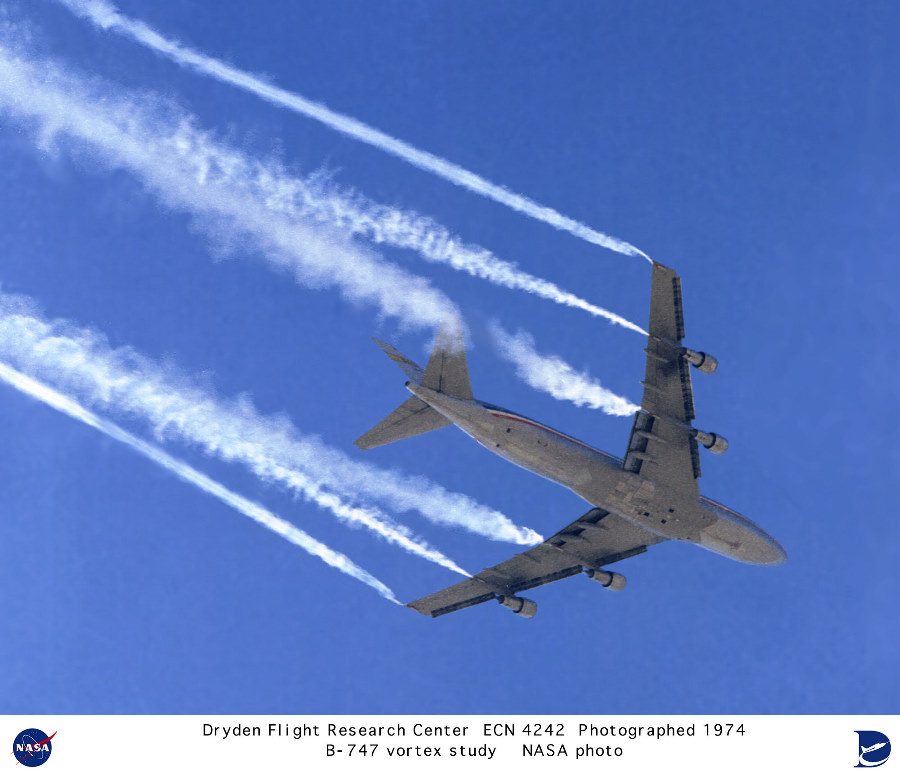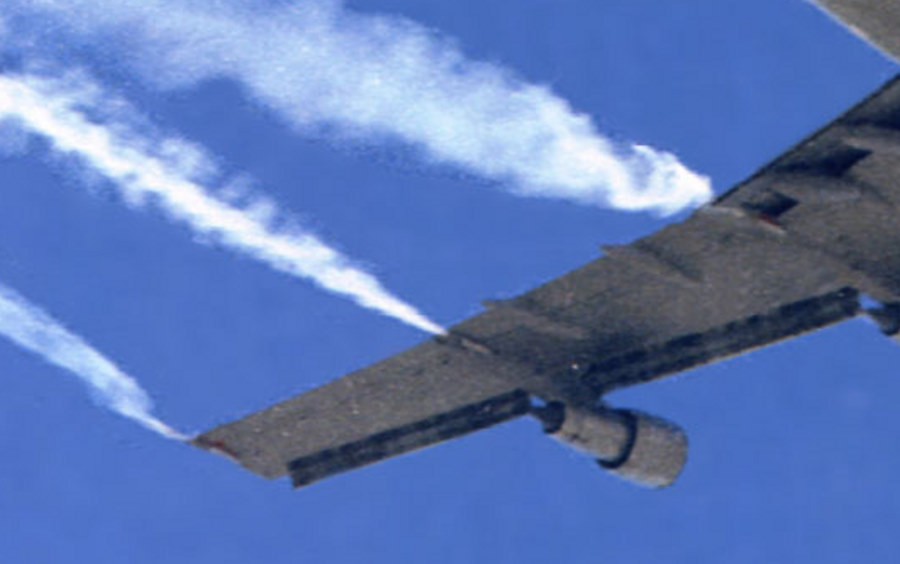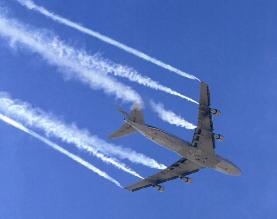|
The Evidence |
||
|
..
Photo Number: ECN-4242 (Click on Image
for full size)
Formats: 558x480 JPEG Image (52 KBytes)
Photo Description: In this 1974 NASA Flight Research Center photograph, a Boeing B-747 jetliner is shown taking part in the trailing wake vortex study. In the photograph, the two wing tip vortex trails, being the strongest, stay in tight cylindrical rolls. The "strength" of the vortices decreases toward the midspan of each wing, and the trails become less defined. ProjectDescription: In 1974 the NASA Flight Research Center (later Dryden Flight Research Center, Edwards, California) used a Boeing 747 as part of the overall NASA study of trailing vortices. Trailing vortices are the invisible flow of spiraling air that trails from the wings of large aircraft and can "upset" smaller aircraft flying behind them. The 747 that NASA used was on loan from the Johnson Space Center where it was part of the Space Shuttle Program. The data gathered in the 747 studies complemented data from the previous (1973-74) joint NASA Flight Research Center and Federal Aviation Administration (FAA) Boeing 727 wake vortices study. Six smoke generators were installed under the wings of the 747 to provide a visual image of the trailing vortices. The object of the experiments was to test different configurations and mechanical devices on the747 that could be used to break up or lessen the strength of the vortices. The results of the tests could lead to shorter spacing between landings and takeoffs, which, in turn, could alleviate air-traffic congestion. For approximately 30 flights the 747 was flown using various combinations of wing air spoilers in an attempt to reduce wake vortices. To evaluate the effectiveness of the different configurations, chase aircraft were flown into the vortex sheets to probe their strengths and patterns at different times. Two of the chase planes used were the Flight Research Centerís Cessna T-37 and the NASA Ames Research Centerís Learjet. These aircraft represented the types of smaller business jets and other small aircraft that might encounter large passenger aircraft on approach or landings around major airports or in flight. Tests without the 747ís wing spoilers deployed produced violent "upset" problems for the T-37 aircraft at a distance of approximately 3 miles. From the magnitude of the problems found, distances of as much as ten miles might be required if spoilers were not used. With two spoilers on the outer wing panels, the T-37 could fly at a distance of three miles and not experience the "upset" problem. The wake vortex study continued even after the 747 was returned to its primary mission of carrying the Space Shuttle. NASA Photo by: NASA
|
||
|
..
From: Royal Meteorological Society Weather Club The explanation for this photo is at: http://www.dfrc.nasa.gov/gallery/photo/B-747/HTML/ECN-4242.html Now the explanation here is that the aircraft has been fitted with "Six smoke generators were installed under the wings of the 747 to provide a visual image of the trailing vortices." These generators appear to be built on to the wings themselves. If you look at the blowups of the photo at http://www.dfrc.nasa.gov/gallery/photo/B-747/Large/ECN-4242.jpg you will see that the smoke generators are very small and not very noticeable. Now if this generator is able to produce smoke, then why not a chemical mixture to form chemtrails. Now if these small generators were to be placed behind each engine, chemical particles could be shot out from the generators and thus mix in together with the jet exhaust. So when the chemicals come out, they are not burned up as or altered if they were mixed with the fuel. Also shielded microplasmas could easily pass from a generator into the exhaust staying in in tact and preserved. This would then allow the clouds to act as storage tanks for microplasmas/viruses/bacteria. Here they could grow then slowly be blown down with the winds or taken down with rain. The key to this is that these generators are small and basically unnoticeable in the air. Crewmen on the ground would notice them but would not know what they are. If they asked they could be told to mind their own business and do their work. So what I would like to see is that trail watchers obtain the very best close up photos they can and to look for these telltale generators. If we can get one photo showing them then the cat is in the bag. Also when you go to air shows, get real close to the military jets and look for generators. Also get close up photos of the back exhaust. If they are highly polished, then we must go back to the theory that chemical particles are in the fuel. Rain water testing has shown the presence of aluminum particles in samples. Will Thomas was told that if aluminum particles are in the fuel, they would act as a polish on the metal. So get those close up shots happening and send them to me for placement. Thank You! http://www.geocities.com/canadianchemtrails/MeterJetPage.html |
||
| FAIR USE NOTICE: This page contains copyrighted material the use of which has not been specifically authorized by the copyright owner. Pegasus Research Consortium distributes this material without profit to those who have expressed a prior interest in receiving the included information for research and educational purposes. We believe this constitutes a fair use of any such copyrighted material as provided for in 17 U.S.C ß 107. If you wish to use copyrighted material from this site for purposes of your own that go beyond fair use, you must obtain permission from the copyright owner. | ||
|
|



